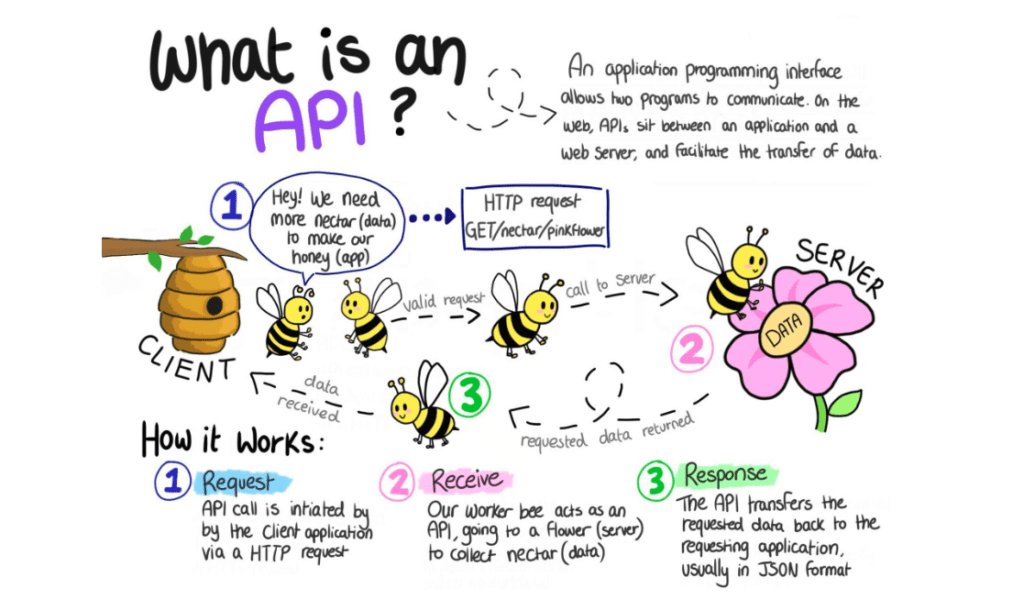What is an API? Full Form, Meaning, Definition, Types & Example
What is an API?
Application Programming Interface (API) is a software interface that allows two applications to interact with each other without any user intervention. API is a collection of software functions and procedures. In simple terms, API means a software code that can be accessed or executed. API is defined as a code that helps two different software’s to communicate and exchange data with each other.
![]()
how does API work?
To understand the functionality of the API, let see the following example:
API Example 1:
Let see how API works using simple daily life example. Imagine that you went to a restaurant to take lunch or dinner. The waiter comes to you gives you a menu card, and you will provide personalize it order like you want a veg sandwich but without onion.
After some time, you will get your order from the waiter. However, it is not that simple as it looks as there is some process that happens in between.
Here, the waiter plays an important part as you will neither go to the kitchen to collect your order nor will you tell the kitchen staff what you want all this done by the waiter.
API also does the same by taking your request, and just like the waiter tell the system what you want and give a response back to you.
API Example 2:
After understanding the concept, let us take some more technical examples.
For example, you go to the movie site, you enter your movie, name, and credit card information, and behold, you print out tickets.
They are collaborating with other applications. This integration is called “seamless,” as you never have a clue when a software role is passed from one application to another.
Why would we need an API?
Here, are some reason for using API:
- Application Programming Interface acronym API helps two different software’s to communicate and exchange data with each other.
- It helps you to embed content from any site or application more efficiently.
- APIs can access app components. The delivery of services and information is more flexible.
- Content generated can be published automatically.
- It allows the user or a company to customize the content and services which they use the most.
- Software needs to change over time, and APIs help to anticipate changes.
Features of API
Here are some important features of API:
- It offers a valuable service (data, function, audience,.).
- It helps you to plan a business model.
- Simple, flexible, quickly adopted.
- Managed and measured.
- Offers great developer support.
Types of API
There are mainly four main types of APIs:
- Open APIs: These types of APIs are publicly available to use like OAuth APIs from Google. It has also not given any restriction to use them. So, they are also known as Public APIs.
- Partner APIs: Specific rights or licenses to access this type of API because they are not available to the public.
- Internal APIs: Internal or private. These APIs are developed by companies to use in their internal systems. It helps you to enhance the productivity of your teams.
- Composite APIs: This type of API combines different data and service APIs.
Communication level of APIs:
Here, are some communication level of APIS:
High-Level APIs:
High-level APIs are those that we can generally use in REST form, where programmers have a high level of abstraction. These API’s mostly concerned about performing a limited functionality.
Low-Level APIs:
This kind of APIs has a lower level of abstraction, which means they are more detailed. It allows the programmer to manipulate functions within an application module or hardware at a granular level.
What is Web APIs?
A Web API is an application programming interface which is use either for web server or a web browser.
Two types of Web APIs are 1) Server-side API 2) Client-side API
1.Server-side:
Server-side web API is a programmatic interface that consist of one or more publicly exposed endpoints to a defined request–response message system. It is typically expressed in JSON or XML
2.Client-side:
A client-side web API is a programmatic interface helps to extend functionality within a web browser or other HTTP client.
Examples of web API:
- Google Maps API’s allow developers to embed Google Maps on webpages by using a JavaScript or Flash interface.
- YouTube API allows developers to integrate YouTube videos and functionality into websites or applications.
- Twitter offers two APIs. The REST API helps developers to access Twitter data, and the search API provides methods for developers to interact with Twitter Search.
- Amazon’s API gives developers access to Amazon’s product selection.
API Testing tools
Here are some popular API tools:
1) Postman
Postman is a plugin in Google Chrome, and it can be used for testing API services. It is a powerful HTTP client to check web services. For manual or exploratory testing, Postman is a good choice for testing API.
![]()
Features:
- With Postman, almost all modern web API data can be extracted
- Helps you to write Boolean tests within Postman Interface
- You can create a collection of REST calls and save each call as part of a collection for execution in future
- For transmitting and receiving REST information, Postman is more reliable.
Download link: https://www.postman.com/
2) Ping API
Ping-API is API testing allows us to write test script in JavaScript and Coffee Script to test your APIs. It will enable inspecting the HTTP API call with a complete request and response data.

- Ping- API to schedule test in every minutes or hour
- Support for writing script to set request headers, body, and URL parameters. It supports for writing script to validate response headers and body
- Validate CRUD flow and log in to Ping API
Download link: https://ping-api.com/
3) v REST
v REST API tool provides an online solution for automated testing, mocking, automatic recording, and specification of REST/HTTP APIs/RESTful APIs.

Features:
- It provides an exhaustive tool to validate your REST APIs quickly
- Helps you to delivers zero-defect web applications with less effort in API testing
- You can validate your web application
- No skilled resources are required, and it can generate documentation for your API specifications.
Download link: https://vrest.io/
Application of API
Here, are important Applications of API (stands for Application Programming Interface):
- Batch Distribution / Drive Traffic.
- Expand Footprint.
- Feature Development
- Explore New Business Models.
- Content Acquisition Advance Business Model.
- Internal Content Distribution / Innovation.
Summary:
- The full form of API is Application Programming Interface.
- API is defined as a software code that helps two different software’s to communicate and exchange data with each other.
- API helps you to plan a business model
- Five types of API are 1) Open API 2) Partner API 3) Internal API 4) High-level 5) Low-level API
- A Web API is an application programming interface which is use either for web server or a web browser.
- There are two types of web APIs 1) Server Side API 2) Client Side API
- Some popular API testing tools are 1) Postman 2) Ping API and 3) v Rest.

No comments:
Post a Comment